Air Pollution: A Comprehensive Overview of Causes and Effects
VerifiedAdded on 2021/09/27
|6
|2635
|402
Report
AI Summary
This report delves into the multifaceted issue of air pollution, exploring its causes, diverse types, and profound effects on both human health and the environment. It highlights the primary sources of air pollution, including energy production and the burning of fossil fuels, which release harmful pollutants like particulate matter, nitrogen dioxide, and ozone. The report details the specific impacts of smog, soot, hazardous air pollutants, greenhouse gases, and allergens like pollen and mold, emphasizing their detrimental effects on respiratory health, cardiovascular systems, and the exacerbation of climate change. Furthermore, it examines the issue of environmental justice, illustrating how communities of color are disproportionately affected by air pollution due to historical and systemic factors. The report also underscores the role of the Clean Air Act in the United States and discusses various strategies for controlling air pollution, emphasizing the need for continued efforts to mitigate its harmful effects and promote cleaner air.
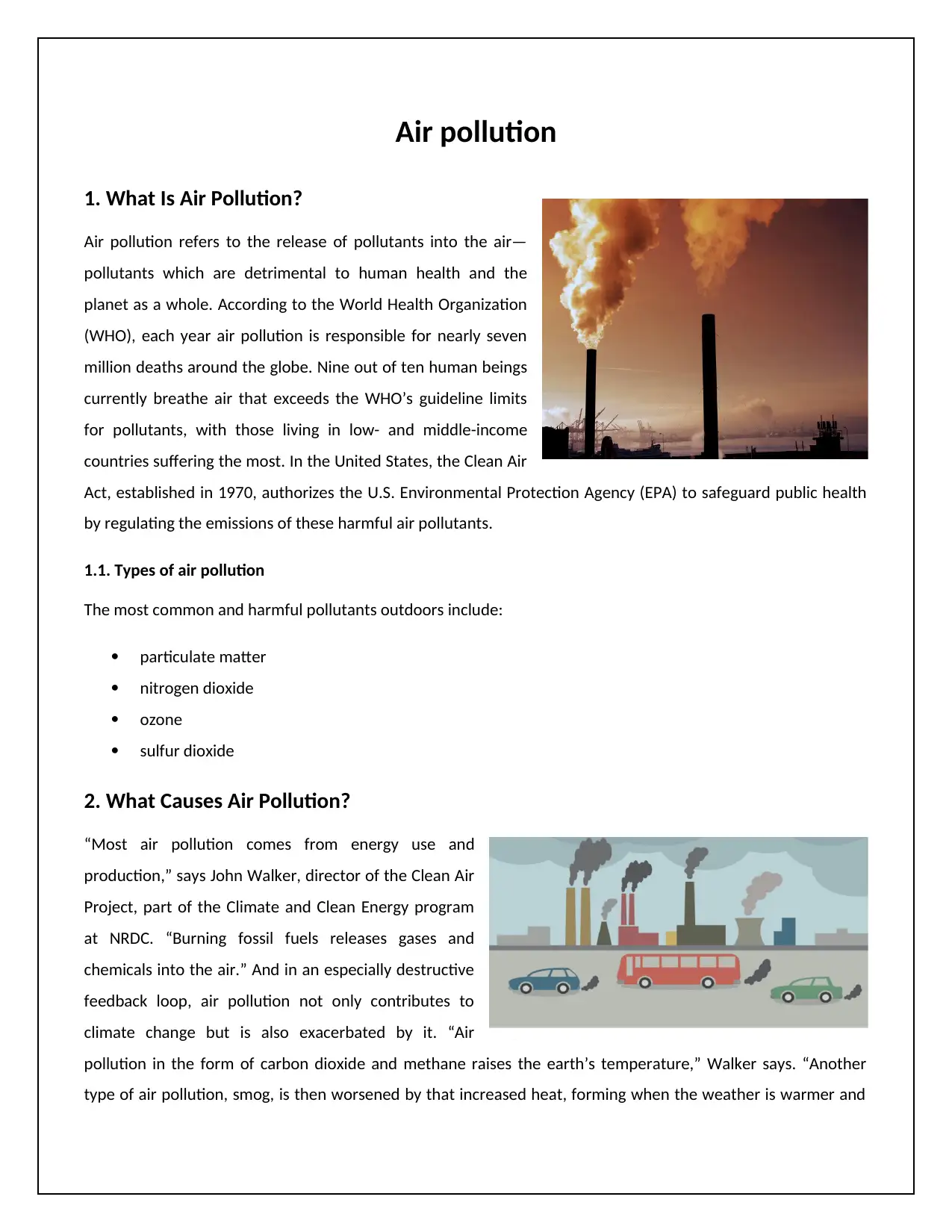
Air pollution
1. What Is Air Pollution?
Air pollution refers to the release of pollutants into the air—
pollutants which are detrimental to human health and the
planet as a whole. According to the World Health Organization
(WHO), each year air pollution is responsible for nearly seven
million deaths around the globe. Nine out of ten human beings
currently breathe air that exceeds the WHO’s guideline limits
for pollutants, with those living in low- and middle-income
countries suffering the most. In the United States, the Clean Air
Act, established in 1970, authorizes the U.S. Environmental Protection Agency (EPA) to safeguard public health
by regulating the emissions of these harmful air pollutants.
1.1. Types of air pollution
The most common and harmful pollutants outdoors include:
particulate matter
nitrogen dioxide
ozone
sulfur dioxide
2. What Causes Air Pollution?
“Most air pollution comes from energy use and
production,” says John Walker, director of the Clean Air
Project, part of the Climate and Clean Energy program
at NRDC. “Burning fossil fuels releases gases and
chemicals into the air.” And in an especially destructive
feedback loop, air pollution not only contributes to
climate change but is also exacerbated by it. “Air
pollution in the form of carbon dioxide and methane raises the earth’s temperature,” Walker says. “Another
type of air pollution, smog, is then worsened by that increased heat, forming when the weather is warmer and
1. What Is Air Pollution?
Air pollution refers to the release of pollutants into the air—
pollutants which are detrimental to human health and the
planet as a whole. According to the World Health Organization
(WHO), each year air pollution is responsible for nearly seven
million deaths around the globe. Nine out of ten human beings
currently breathe air that exceeds the WHO’s guideline limits
for pollutants, with those living in low- and middle-income
countries suffering the most. In the United States, the Clean Air
Act, established in 1970, authorizes the U.S. Environmental Protection Agency (EPA) to safeguard public health
by regulating the emissions of these harmful air pollutants.
1.1. Types of air pollution
The most common and harmful pollutants outdoors include:
particulate matter
nitrogen dioxide
ozone
sulfur dioxide
2. What Causes Air Pollution?
“Most air pollution comes from energy use and
production,” says John Walker, director of the Clean Air
Project, part of the Climate and Clean Energy program
at NRDC. “Burning fossil fuels releases gases and
chemicals into the air.” And in an especially destructive
feedback loop, air pollution not only contributes to
climate change but is also exacerbated by it. “Air
pollution in the form of carbon dioxide and methane raises the earth’s temperature,” Walker says. “Another
type of air pollution, smog, is then worsened by that increased heat, forming when the weather is warmer and
Paraphrase This Document
Need a fresh take? Get an instant paraphrase of this document with our AI Paraphraser
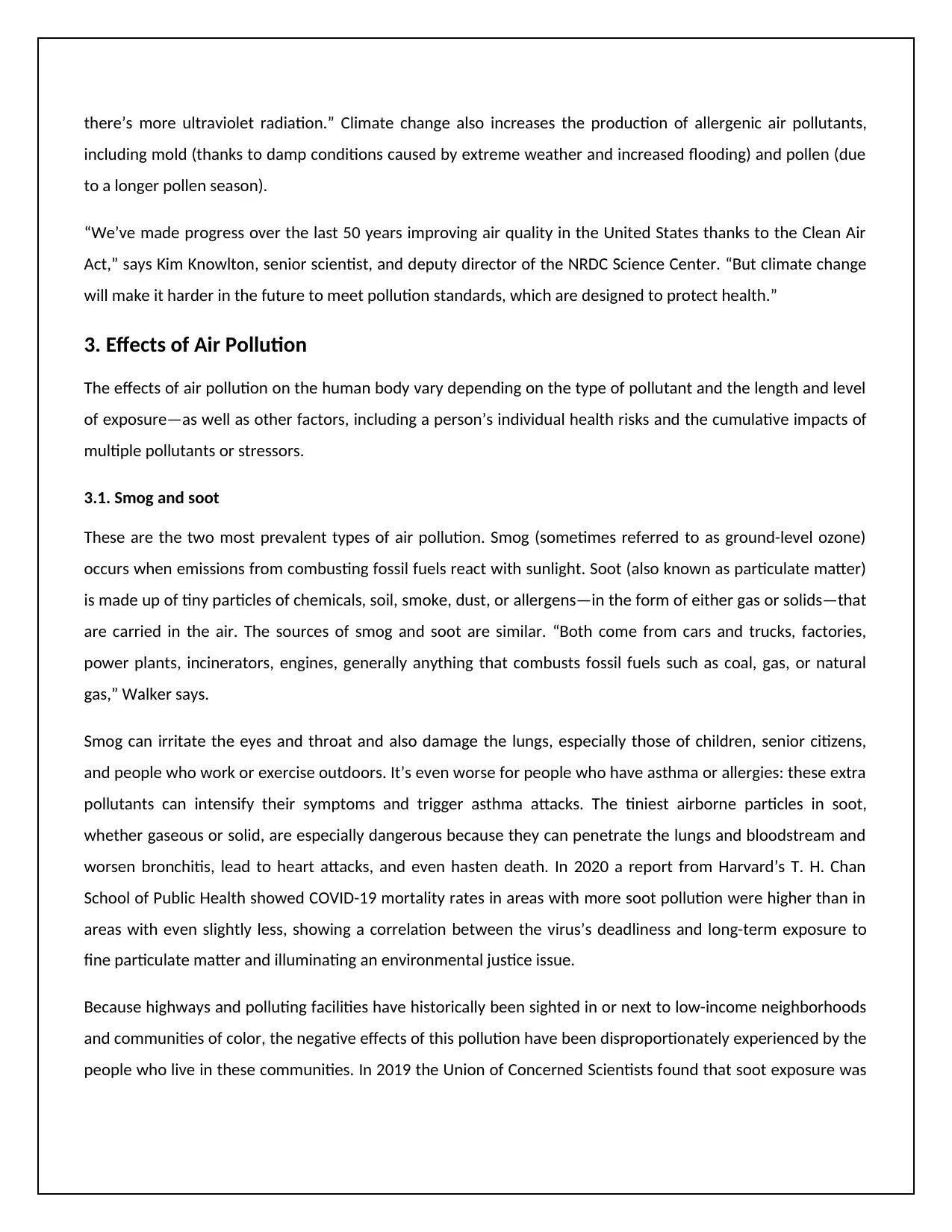
there’s more ultraviolet radiation.” Climate change also increases the production of allergenic air pollutants,
including mold (thanks to damp conditions caused by extreme weather and increased flooding) and pollen (due
to a longer pollen season).
“We’ve made progress over the last 50 years improving air quality in the United States thanks to the Clean Air
Act,” says Kim Knowlton, senior scientist, and deputy director of the NRDC Science Center. “But climate change
will make it harder in the future to meet pollution standards, which are designed to protect health.”
3. Effects of Air Pollution
The effects of air pollution on the human body vary depending on the type of pollutant and the length and level
of exposure—as well as other factors, including a person’s individual health risks and the cumulative impacts of
multiple pollutants or stressors.
3.1. Smog and soot
These are the two most prevalent types of air pollution. Smog (sometimes referred to as ground-level ozone)
occurs when emissions from combusting fossil fuels react with sunlight. Soot (also known as particulate matter)
is made up of tiny particles of chemicals, soil, smoke, dust, or allergens—in the form of either gas or solids—that
are carried in the air. The sources of smog and soot are similar. “Both come from cars and trucks, factories,
power plants, incinerators, engines, generally anything that combusts fossil fuels such as coal, gas, or natural
gas,” Walker says.
Smog can irritate the eyes and throat and also damage the lungs, especially those of children, senior citizens,
and people who work or exercise outdoors. It’s even worse for people who have asthma or allergies: these extra
pollutants can intensify their symptoms and trigger asthma attacks. The tiniest airborne particles in soot,
whether gaseous or solid, are especially dangerous because they can penetrate the lungs and bloodstream and
worsen bronchitis, lead to heart attacks, and even hasten death. In 2020 a report from Harvard’s T. H. Chan
School of Public Health showed COVID-19 mortality rates in areas with more soot pollution were higher than in
areas with even slightly less, showing a correlation between the virus’s deadliness and long-term exposure to
fine particulate matter and illuminating an environmental justice issue.
Because highways and polluting facilities have historically been sighted in or next to low-income neighborhoods
and communities of color, the negative effects of this pollution have been disproportionately experienced by the
people who live in these communities. In 2019 the Union of Concerned Scientists found that soot exposure was
including mold (thanks to damp conditions caused by extreme weather and increased flooding) and pollen (due
to a longer pollen season).
“We’ve made progress over the last 50 years improving air quality in the United States thanks to the Clean Air
Act,” says Kim Knowlton, senior scientist, and deputy director of the NRDC Science Center. “But climate change
will make it harder in the future to meet pollution standards, which are designed to protect health.”
3. Effects of Air Pollution
The effects of air pollution on the human body vary depending on the type of pollutant and the length and level
of exposure—as well as other factors, including a person’s individual health risks and the cumulative impacts of
multiple pollutants or stressors.
3.1. Smog and soot
These are the two most prevalent types of air pollution. Smog (sometimes referred to as ground-level ozone)
occurs when emissions from combusting fossil fuels react with sunlight. Soot (also known as particulate matter)
is made up of tiny particles of chemicals, soil, smoke, dust, or allergens—in the form of either gas or solids—that
are carried in the air. The sources of smog and soot are similar. “Both come from cars and trucks, factories,
power plants, incinerators, engines, generally anything that combusts fossil fuels such as coal, gas, or natural
gas,” Walker says.
Smog can irritate the eyes and throat and also damage the lungs, especially those of children, senior citizens,
and people who work or exercise outdoors. It’s even worse for people who have asthma or allergies: these extra
pollutants can intensify their symptoms and trigger asthma attacks. The tiniest airborne particles in soot,
whether gaseous or solid, are especially dangerous because they can penetrate the lungs and bloodstream and
worsen bronchitis, lead to heart attacks, and even hasten death. In 2020 a report from Harvard’s T. H. Chan
School of Public Health showed COVID-19 mortality rates in areas with more soot pollution were higher than in
areas with even slightly less, showing a correlation between the virus’s deadliness and long-term exposure to
fine particulate matter and illuminating an environmental justice issue.
Because highways and polluting facilities have historically been sighted in or next to low-income neighborhoods
and communities of color, the negative effects of this pollution have been disproportionately experienced by the
people who live in these communities. In 2019 the Union of Concerned Scientists found that soot exposure was
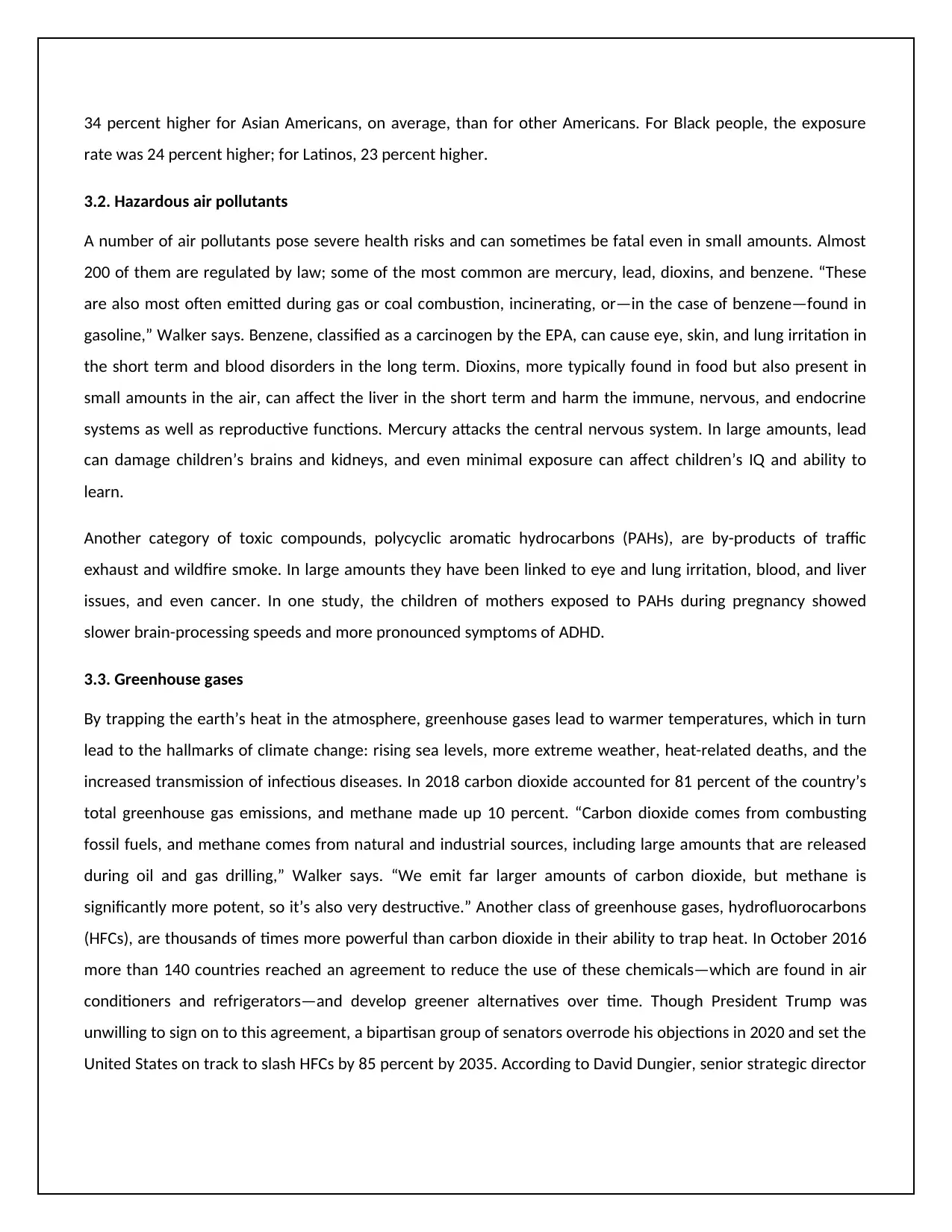
34 percent higher for Asian Americans, on average, than for other Americans. For Black people, the exposure
rate was 24 percent higher; for Latinos, 23 percent higher.
3.2. Hazardous air pollutants
A number of air pollutants pose severe health risks and can sometimes be fatal even in small amounts. Almost
200 of them are regulated by law; some of the most common are mercury, lead, dioxins, and benzene. “These
are also most often emitted during gas or coal combustion, incinerating, or—in the case of benzene—found in
gasoline,” Walker says. Benzene, classified as a carcinogen by the EPA, can cause eye, skin, and lung irritation in
the short term and blood disorders in the long term. Dioxins, more typically found in food but also present in
small amounts in the air, can affect the liver in the short term and harm the immune, nervous, and endocrine
systems as well as reproductive functions. Mercury attacks the central nervous system. In large amounts, lead
can damage children’s brains and kidneys, and even minimal exposure can affect children’s IQ and ability to
learn.
Another category of toxic compounds, polycyclic aromatic hydrocarbons (PAHs), are by-products of traffic
exhaust and wildfire smoke. In large amounts they have been linked to eye and lung irritation, blood, and liver
issues, and even cancer. In one study, the children of mothers exposed to PAHs during pregnancy showed
slower brain-processing speeds and more pronounced symptoms of ADHD.
3.3. Greenhouse gases
By trapping the earth’s heat in the atmosphere, greenhouse gases lead to warmer temperatures, which in turn
lead to the hallmarks of climate change: rising sea levels, more extreme weather, heat-related deaths, and the
increased transmission of infectious diseases. In 2018 carbon dioxide accounted for 81 percent of the country’s
total greenhouse gas emissions, and methane made up 10 percent. “Carbon dioxide comes from combusting
fossil fuels, and methane comes from natural and industrial sources, including large amounts that are released
during oil and gas drilling,” Walker says. “We emit far larger amounts of carbon dioxide, but methane is
significantly more potent, so it’s also very destructive.” Another class of greenhouse gases, hydrofluorocarbons
(HFCs), are thousands of times more powerful than carbon dioxide in their ability to trap heat. In October 2016
more than 140 countries reached an agreement to reduce the use of these chemicals—which are found in air
conditioners and refrigerators—and develop greener alternatives over time. Though President Trump was
unwilling to sign on to this agreement, a bipartisan group of senators overrode his objections in 2020 and set the
United States on track to slash HFCs by 85 percent by 2035. According to David Dungier, senior strategic director
rate was 24 percent higher; for Latinos, 23 percent higher.
3.2. Hazardous air pollutants
A number of air pollutants pose severe health risks and can sometimes be fatal even in small amounts. Almost
200 of them are regulated by law; some of the most common are mercury, lead, dioxins, and benzene. “These
are also most often emitted during gas or coal combustion, incinerating, or—in the case of benzene—found in
gasoline,” Walker says. Benzene, classified as a carcinogen by the EPA, can cause eye, skin, and lung irritation in
the short term and blood disorders in the long term. Dioxins, more typically found in food but also present in
small amounts in the air, can affect the liver in the short term and harm the immune, nervous, and endocrine
systems as well as reproductive functions. Mercury attacks the central nervous system. In large amounts, lead
can damage children’s brains and kidneys, and even minimal exposure can affect children’s IQ and ability to
learn.
Another category of toxic compounds, polycyclic aromatic hydrocarbons (PAHs), are by-products of traffic
exhaust and wildfire smoke. In large amounts they have been linked to eye and lung irritation, blood, and liver
issues, and even cancer. In one study, the children of mothers exposed to PAHs during pregnancy showed
slower brain-processing speeds and more pronounced symptoms of ADHD.
3.3. Greenhouse gases
By trapping the earth’s heat in the atmosphere, greenhouse gases lead to warmer temperatures, which in turn
lead to the hallmarks of climate change: rising sea levels, more extreme weather, heat-related deaths, and the
increased transmission of infectious diseases. In 2018 carbon dioxide accounted for 81 percent of the country’s
total greenhouse gas emissions, and methane made up 10 percent. “Carbon dioxide comes from combusting
fossil fuels, and methane comes from natural and industrial sources, including large amounts that are released
during oil and gas drilling,” Walker says. “We emit far larger amounts of carbon dioxide, but methane is
significantly more potent, so it’s also very destructive.” Another class of greenhouse gases, hydrofluorocarbons
(HFCs), are thousands of times more powerful than carbon dioxide in their ability to trap heat. In October 2016
more than 140 countries reached an agreement to reduce the use of these chemicals—which are found in air
conditioners and refrigerators—and develop greener alternatives over time. Though President Trump was
unwilling to sign on to this agreement, a bipartisan group of senators overrode his objections in 2020 and set the
United States on track to slash HFCs by 85 percent by 2035. According to David Dungier, senior strategic director
⊘ This is a preview!⊘
Do you want full access?
Subscribe today to unlock all pages.

Trusted by 1+ million students worldwide
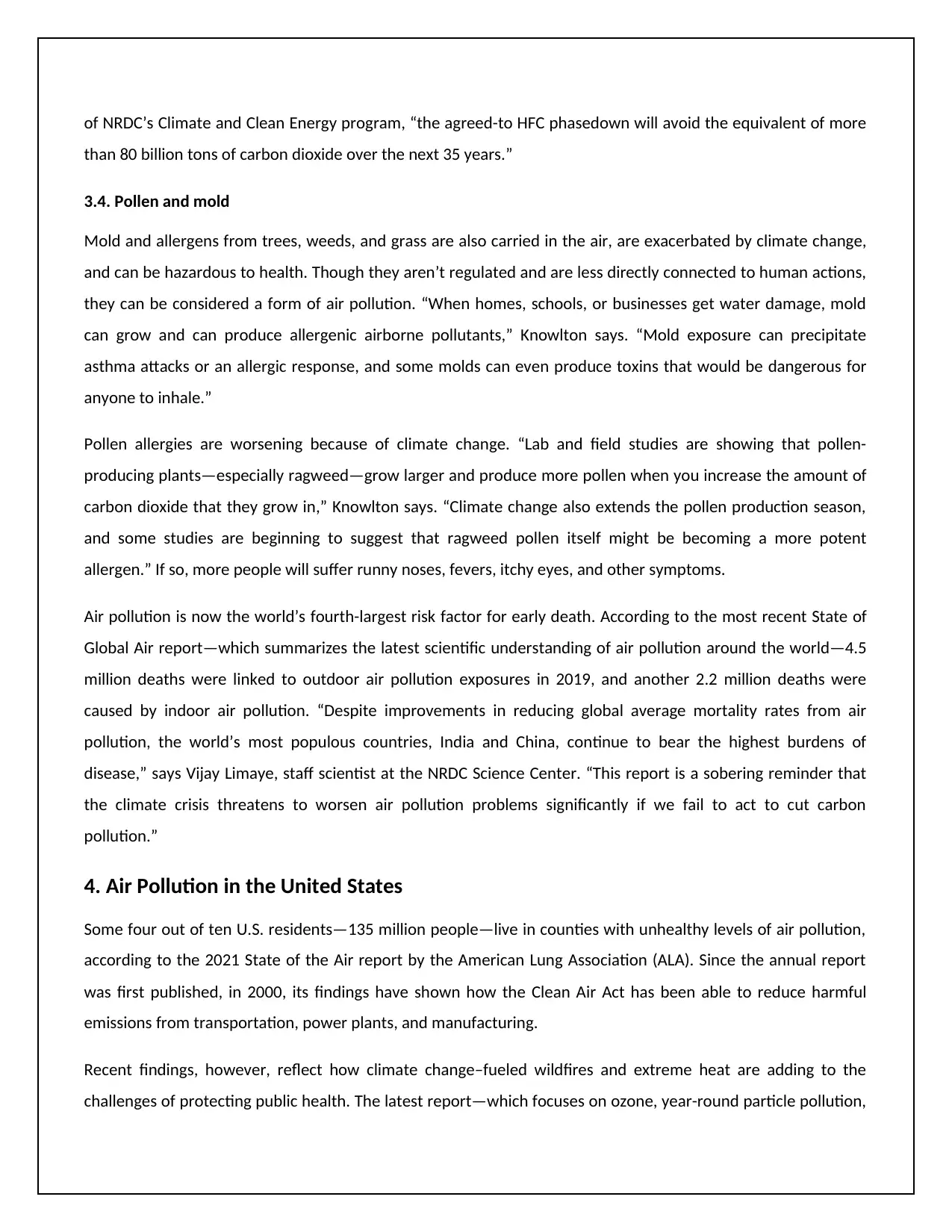
of NRDC’s Climate and Clean Energy program, “the agreed-to HFC phasedown will avoid the equivalent of more
than 80 billion tons of carbon dioxide over the next 35 years.”
3.4. Pollen and mold
Mold and allergens from trees, weeds, and grass are also carried in the air, are exacerbated by climate change,
and can be hazardous to health. Though they aren’t regulated and are less directly connected to human actions,
they can be considered a form of air pollution. “When homes, schools, or businesses get water damage, mold
can grow and can produce allergenic airborne pollutants,” Knowlton says. “Mold exposure can precipitate
asthma attacks or an allergic response, and some molds can even produce toxins that would be dangerous for
anyone to inhale.”
Pollen allergies are worsening because of climate change. “Lab and field studies are showing that pollen-
producing plants—especially ragweed—grow larger and produce more pollen when you increase the amount of
carbon dioxide that they grow in,” Knowlton says. “Climate change also extends the pollen production season,
and some studies are beginning to suggest that ragweed pollen itself might be becoming a more potent
allergen.” If so, more people will suffer runny noses, fevers, itchy eyes, and other symptoms.
Air pollution is now the world’s fourth-largest risk factor for early death. According to the most recent State of
Global Air report—which summarizes the latest scientific understanding of air pollution around the world—4.5
million deaths were linked to outdoor air pollution exposures in 2019, and another 2.2 million deaths were
caused by indoor air pollution. “Despite improvements in reducing global average mortality rates from air
pollution, the world’s most populous countries, India and China, continue to bear the highest burdens of
disease,” says Vijay Limaye, staff scientist at the NRDC Science Center. “This report is a sobering reminder that
the climate crisis threatens to worsen air pollution problems significantly if we fail to act to cut carbon
pollution.”
4. Air Pollution in the United States
Some four out of ten U.S. residents—135 million people—live in counties with unhealthy levels of air pollution,
according to the 2021 State of the Air report by the American Lung Association (ALA). Since the annual report
was first published, in 2000, its findings have shown how the Clean Air Act has been able to reduce harmful
emissions from transportation, power plants, and manufacturing.
Recent findings, however, reflect how climate change–fueled wildfires and extreme heat are adding to the
challenges of protecting public health. The latest report—which focuses on ozone, year-round particle pollution,
than 80 billion tons of carbon dioxide over the next 35 years.”
3.4. Pollen and mold
Mold and allergens from trees, weeds, and grass are also carried in the air, are exacerbated by climate change,
and can be hazardous to health. Though they aren’t regulated and are less directly connected to human actions,
they can be considered a form of air pollution. “When homes, schools, or businesses get water damage, mold
can grow and can produce allergenic airborne pollutants,” Knowlton says. “Mold exposure can precipitate
asthma attacks or an allergic response, and some molds can even produce toxins that would be dangerous for
anyone to inhale.”
Pollen allergies are worsening because of climate change. “Lab and field studies are showing that pollen-
producing plants—especially ragweed—grow larger and produce more pollen when you increase the amount of
carbon dioxide that they grow in,” Knowlton says. “Climate change also extends the pollen production season,
and some studies are beginning to suggest that ragweed pollen itself might be becoming a more potent
allergen.” If so, more people will suffer runny noses, fevers, itchy eyes, and other symptoms.
Air pollution is now the world’s fourth-largest risk factor for early death. According to the most recent State of
Global Air report—which summarizes the latest scientific understanding of air pollution around the world—4.5
million deaths were linked to outdoor air pollution exposures in 2019, and another 2.2 million deaths were
caused by indoor air pollution. “Despite improvements in reducing global average mortality rates from air
pollution, the world’s most populous countries, India and China, continue to bear the highest burdens of
disease,” says Vijay Limaye, staff scientist at the NRDC Science Center. “This report is a sobering reminder that
the climate crisis threatens to worsen air pollution problems significantly if we fail to act to cut carbon
pollution.”
4. Air Pollution in the United States
Some four out of ten U.S. residents—135 million people—live in counties with unhealthy levels of air pollution,
according to the 2021 State of the Air report by the American Lung Association (ALA). Since the annual report
was first published, in 2000, its findings have shown how the Clean Air Act has been able to reduce harmful
emissions from transportation, power plants, and manufacturing.
Recent findings, however, reflect how climate change–fueled wildfires and extreme heat are adding to the
challenges of protecting public health. The latest report—which focuses on ozone, year-round particle pollution,
Paraphrase This Document
Need a fresh take? Get an instant paraphrase of this document with our AI Paraphraser
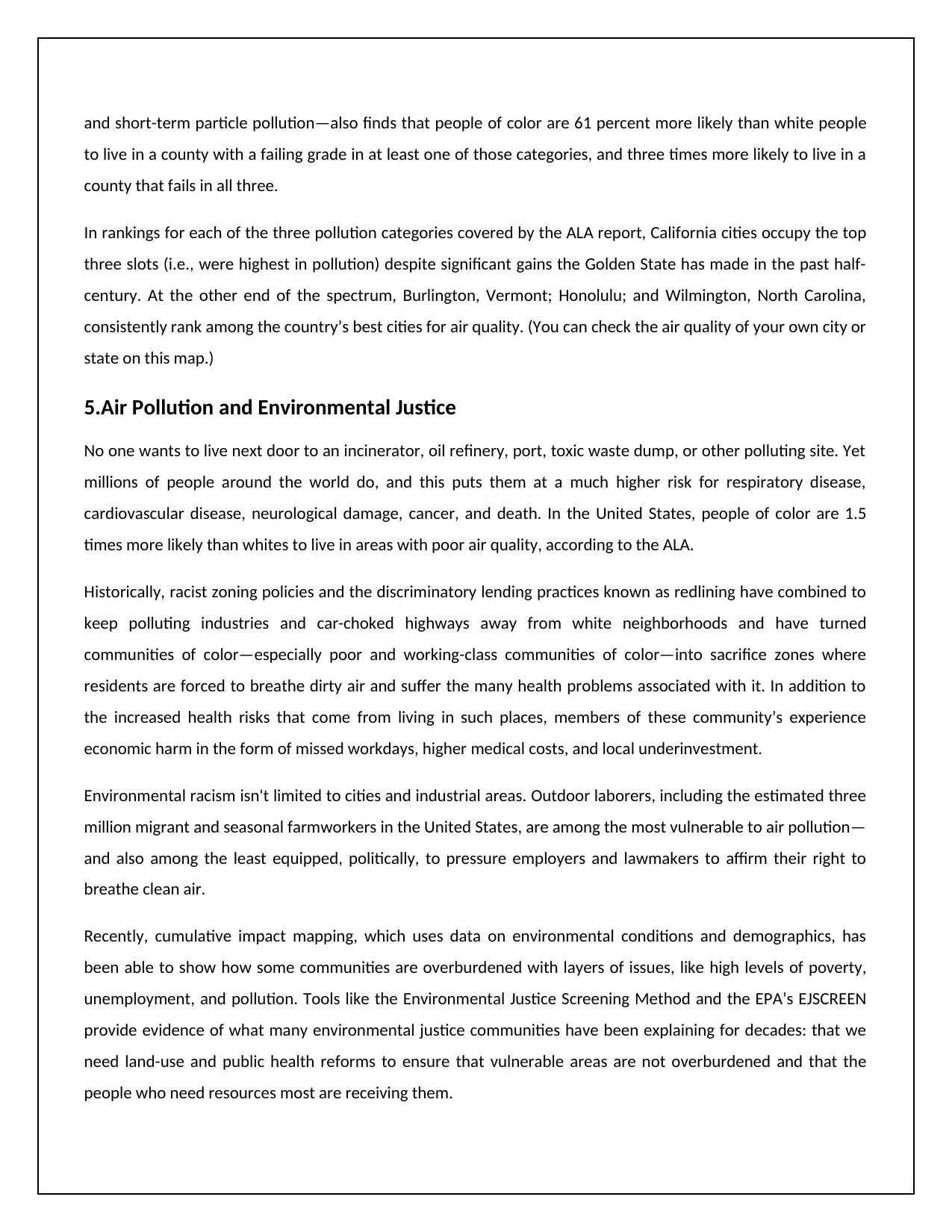
and short-term particle pollution—also finds that people of color are 61 percent more likely than white people
to live in a county with a failing grade in at least one of those categories, and three times more likely to live in a
county that fails in all three.
In rankings for each of the three pollution categories covered by the ALA report, California cities occupy the top
three slots (i.e., were highest in pollution) despite significant gains the Golden State has made in the past half-
century. At the other end of the spectrum, Burlington, Vermont; Honolulu; and Wilmington, North Carolina,
consistently rank among the country’s best cities for air quality. (You can check the air quality of your own city or
state on this map.)
5.Air Pollution and Environmental Justice
No one wants to live next door to an incinerator, oil refinery, port, toxic waste dump, or other polluting site. Yet
millions of people around the world do, and this puts them at a much higher risk for respiratory disease,
cardiovascular disease, neurological damage, cancer, and death. In the United States, people of color are 1.5
times more likely than whites to live in areas with poor air quality, according to the ALA.
Historically, racist zoning policies and the discriminatory lending practices known as redlining have combined to
keep polluting industries and car-choked highways away from white neighborhoods and have turned
communities of color—especially poor and working-class communities of color—into sacrifice zones where
residents are forced to breathe dirty air and suffer the many health problems associated with it. In addition to
the increased health risks that come from living in such places, members of these community’s experience
economic harm in the form of missed workdays, higher medical costs, and local underinvestment.
Environmental racism isn't limited to cities and industrial areas. Outdoor laborers, including the estimated three
million migrant and seasonal farmworkers in the United States, are among the most vulnerable to air pollution—
and also among the least equipped, politically, to pressure employers and lawmakers to affirm their right to
breathe clean air.
Recently, cumulative impact mapping, which uses data on environmental conditions and demographics, has
been able to show how some communities are overburdened with layers of issues, like high levels of poverty,
unemployment, and pollution. Tools like the Environmental Justice Screening Method and the EPA’s EJSCREEN
provide evidence of what many environmental justice communities have been explaining for decades: that we
need land-use and public health reforms to ensure that vulnerable areas are not overburdened and that the
people who need resources most are receiving them.
to live in a county with a failing grade in at least one of those categories, and three times more likely to live in a
county that fails in all three.
In rankings for each of the three pollution categories covered by the ALA report, California cities occupy the top
three slots (i.e., were highest in pollution) despite significant gains the Golden State has made in the past half-
century. At the other end of the spectrum, Burlington, Vermont; Honolulu; and Wilmington, North Carolina,
consistently rank among the country’s best cities for air quality. (You can check the air quality of your own city or
state on this map.)
5.Air Pollution and Environmental Justice
No one wants to live next door to an incinerator, oil refinery, port, toxic waste dump, or other polluting site. Yet
millions of people around the world do, and this puts them at a much higher risk for respiratory disease,
cardiovascular disease, neurological damage, cancer, and death. In the United States, people of color are 1.5
times more likely than whites to live in areas with poor air quality, according to the ALA.
Historically, racist zoning policies and the discriminatory lending practices known as redlining have combined to
keep polluting industries and car-choked highways away from white neighborhoods and have turned
communities of color—especially poor and working-class communities of color—into sacrifice zones where
residents are forced to breathe dirty air and suffer the many health problems associated with it. In addition to
the increased health risks that come from living in such places, members of these community’s experience
economic harm in the form of missed workdays, higher medical costs, and local underinvestment.
Environmental racism isn't limited to cities and industrial areas. Outdoor laborers, including the estimated three
million migrant and seasonal farmworkers in the United States, are among the most vulnerable to air pollution—
and also among the least equipped, politically, to pressure employers and lawmakers to affirm their right to
breathe clean air.
Recently, cumulative impact mapping, which uses data on environmental conditions and demographics, has
been able to show how some communities are overburdened with layers of issues, like high levels of poverty,
unemployment, and pollution. Tools like the Environmental Justice Screening Method and the EPA’s EJSCREEN
provide evidence of what many environmental justice communities have been explaining for decades: that we
need land-use and public health reforms to ensure that vulnerable areas are not overburdened and that the
people who need resources most are receiving them.
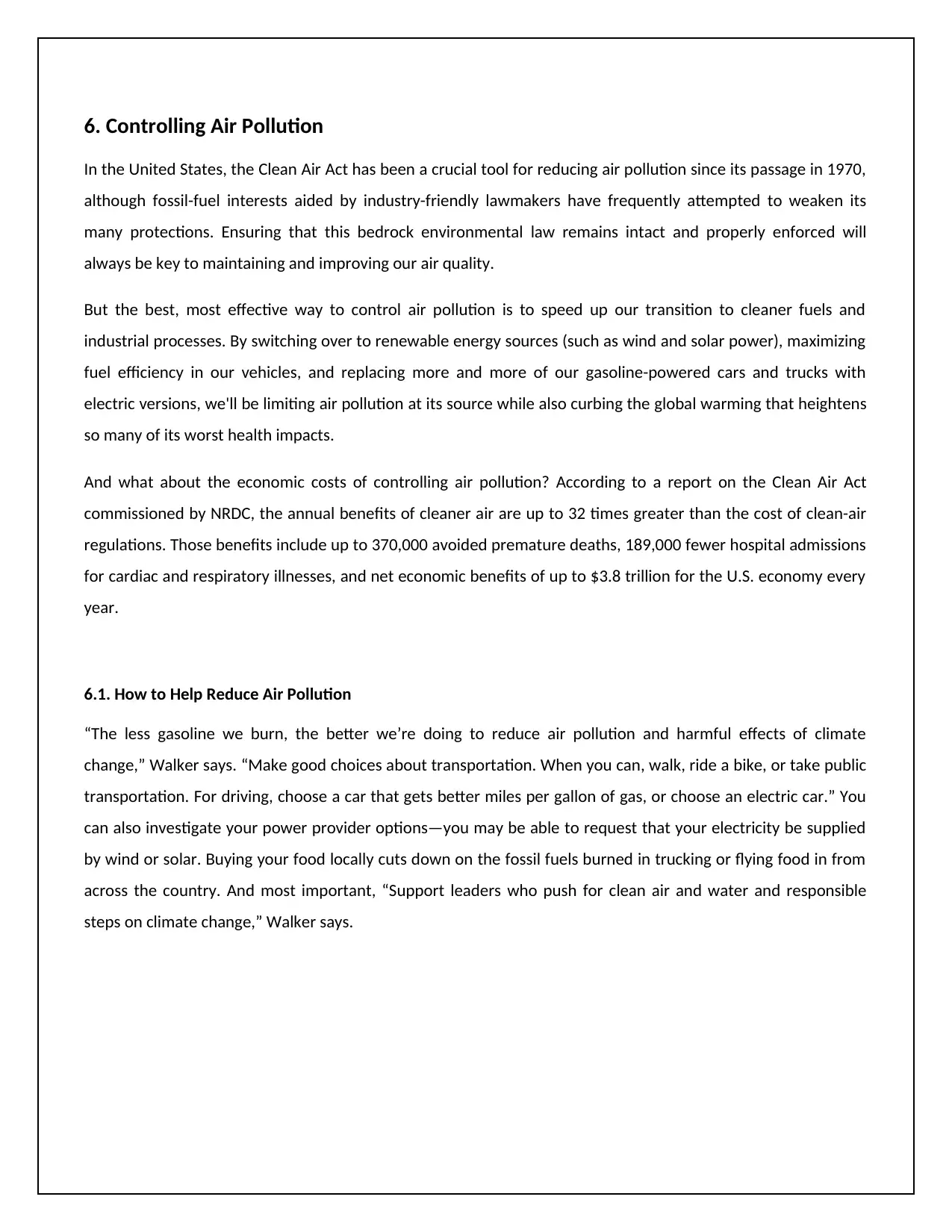
6. Controlling Air Pollution
In the United States, the Clean Air Act has been a crucial tool for reducing air pollution since its passage in 1970,
although fossil-fuel interests aided by industry-friendly lawmakers have frequently attempted to weaken its
many protections. Ensuring that this bedrock environmental law remains intact and properly enforced will
always be key to maintaining and improving our air quality.
But the best, most effective way to control air pollution is to speed up our transition to cleaner fuels and
industrial processes. By switching over to renewable energy sources (such as wind and solar power), maximizing
fuel efficiency in our vehicles, and replacing more and more of our gasoline-powered cars and trucks with
electric versions, we'll be limiting air pollution at its source while also curbing the global warming that heightens
so many of its worst health impacts.
And what about the economic costs of controlling air pollution? According to a report on the Clean Air Act
commissioned by NRDC, the annual benefits of cleaner air are up to 32 times greater than the cost of clean-air
regulations. Those benefits include up to 370,000 avoided premature deaths, 189,000 fewer hospital admissions
for cardiac and respiratory illnesses, and net economic benefits of up to $3.8 trillion for the U.S. economy every
year.
6.1. How to Help Reduce Air Pollution
“The less gasoline we burn, the better we’re doing to reduce air pollution and harmful effects of climate
change,” Walker says. “Make good choices about transportation. When you can, walk, ride a bike, or take public
transportation. For driving, choose a car that gets better miles per gallon of gas, or choose an electric car.” You
can also investigate your power provider options—you may be able to request that your electricity be supplied
by wind or solar. Buying your food locally cuts down on the fossil fuels burned in trucking or flying food in from
across the country. And most important, “Support leaders who push for clean air and water and responsible
steps on climate change,” Walker says.
In the United States, the Clean Air Act has been a crucial tool for reducing air pollution since its passage in 1970,
although fossil-fuel interests aided by industry-friendly lawmakers have frequently attempted to weaken its
many protections. Ensuring that this bedrock environmental law remains intact and properly enforced will
always be key to maintaining and improving our air quality.
But the best, most effective way to control air pollution is to speed up our transition to cleaner fuels and
industrial processes. By switching over to renewable energy sources (such as wind and solar power), maximizing
fuel efficiency in our vehicles, and replacing more and more of our gasoline-powered cars and trucks with
electric versions, we'll be limiting air pollution at its source while also curbing the global warming that heightens
so many of its worst health impacts.
And what about the economic costs of controlling air pollution? According to a report on the Clean Air Act
commissioned by NRDC, the annual benefits of cleaner air are up to 32 times greater than the cost of clean-air
regulations. Those benefits include up to 370,000 avoided premature deaths, 189,000 fewer hospital admissions
for cardiac and respiratory illnesses, and net economic benefits of up to $3.8 trillion for the U.S. economy every
year.
6.1. How to Help Reduce Air Pollution
“The less gasoline we burn, the better we’re doing to reduce air pollution and harmful effects of climate
change,” Walker says. “Make good choices about transportation. When you can, walk, ride a bike, or take public
transportation. For driving, choose a car that gets better miles per gallon of gas, or choose an electric car.” You
can also investigate your power provider options—you may be able to request that your electricity be supplied
by wind or solar. Buying your food locally cuts down on the fossil fuels burned in trucking or flying food in from
across the country. And most important, “Support leaders who push for clean air and water and responsible
steps on climate change,” Walker says.
⊘ This is a preview!⊘
Do you want full access?
Subscribe today to unlock all pages.

Trusted by 1+ million students worldwide
1 out of 6
Related Documents
Your All-in-One AI-Powered Toolkit for Academic Success.
+13062052269
info@desklib.com
Available 24*7 on WhatsApp / Email
![[object Object]](/_next/static/media/star-bottom.7253800d.svg)
Unlock your academic potential
Copyright © 2020–2026 A2Z Services. All Rights Reserved. Developed and managed by ZUCOL.





